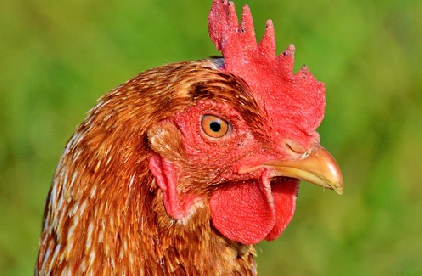
A third case of bird flu has been detected in England at a premises near Leominster in North Herefordshire - after two other cases were discovered last week.
The latest case in broiler breeder chickens follows those found in Cheshire and Kent on 2 November.
Birds are being culled and control zones have been put in place, the government has confirmed.
Bird flu is a name used to refer to a variety of virus strains that infect birds. It first emerged in 2007 but has rarely spread from birds to humans.
Authorities say they are taking "immediate and robust action" after the H5N8 strain was found in Herefordshire and Cheshire, and H5N2 was confirmed in Kent.
A series of outbreaks of the highly pathogenic bird flu have been reported in Europe in past few weeks.
Two cases of H5N8 bird flu have been confirmed on farms in the German state of Schleswig-Holstein and on Tuesday
Dutch health officials ordered the culling of 48,000 chickens following a separate outbreak.
Wild birds are believed to be spreading the disease.
Testing in Cheshire confirmed the "highly pathogenic strain" is related to the virus currently circulating on the continent, the government said. Then, 13,000 birds were humanely culled.
An investigation has been started into the origin of the disease in each of the cases, the government has said.
All areas in Great Britain remain at risk of bird flu in wild birds.
Prior to this, the last outbreak was confirmed at a commercial chicken farm in Mid Suffolk on 10 December 2019.
The H5N6 strain of avian influenza was confirmed in 21 wild birds between January and June 2018. There were no cases in poultry.
According to the NHS the H5N8 strain has not infected any humans worldwide to date, while H5N6 hasn't infected anyone in the UK and doesn't spread from humans to birds easily.
In June a new strain of swine flu, similar to the one that caused a pandemic in 2008, was identified in China.
Named G4 EA H1N1, it possesses "all the essential hallmarks of a candidate pandemic virus", according to the authors of a scientific study.

© Sky News 2020

 MP raises concerns over future of Post Office network
MP raises concerns over future of Post Office network
 County ‘needs to stop using this chemical’ says North Herefordshire MP
County ‘needs to stop using this chemical’ says North Herefordshire MP
 Statue of Lord Hill on The Column to be repaired
Statue of Lord Hill on The Column to be repaired
 Ludlow concerts draw 40,000 people
Ludlow concerts draw 40,000 people
 Power company ‘tripling capacity’ of overhead lines to ‘reinforce’ network
Power company ‘tripling capacity’ of overhead lines to ‘reinforce’ network
 Church to take “enforcement action” against council
Church to take “enforcement action” against council
 Lorry driver taken to hospital after crash
Lorry driver taken to hospital after crash
 Agencies campaign to prevent heart-wrenching water tragedies
Agencies campaign to prevent heart-wrenching water tragedies
